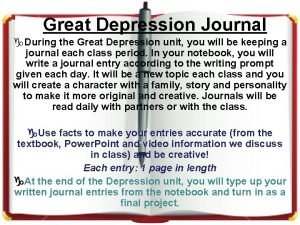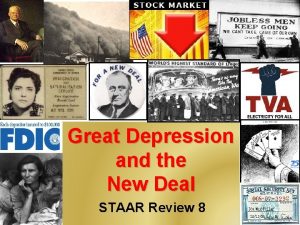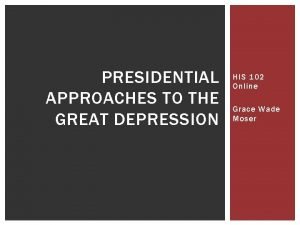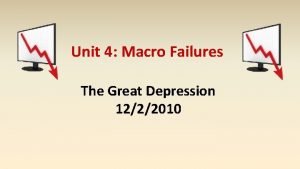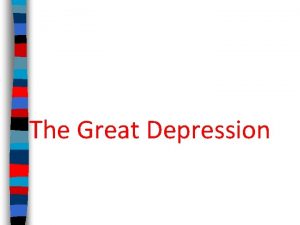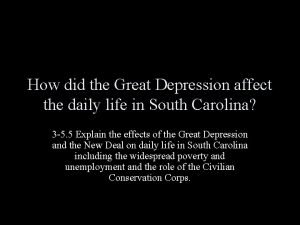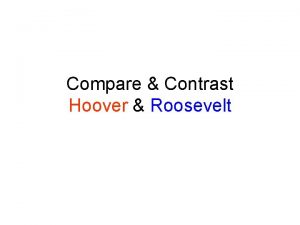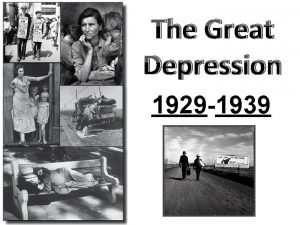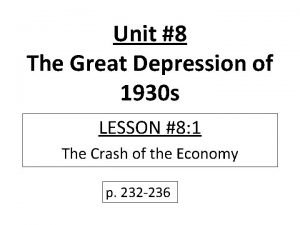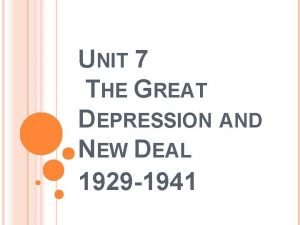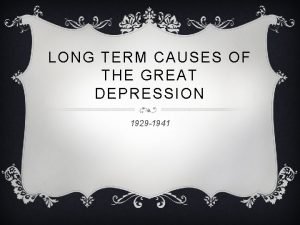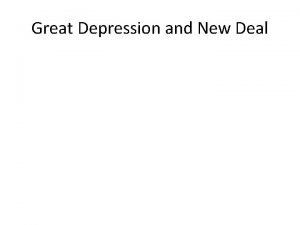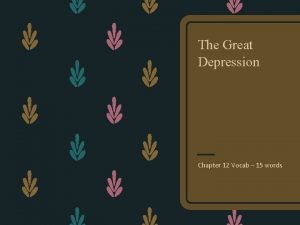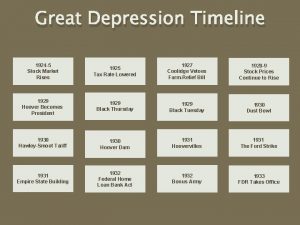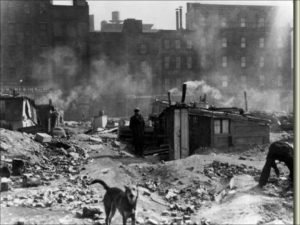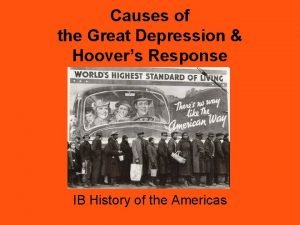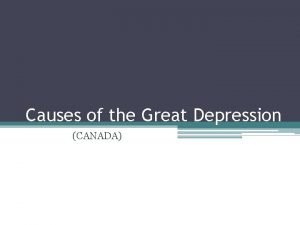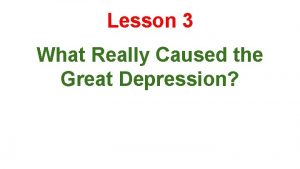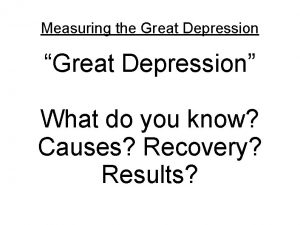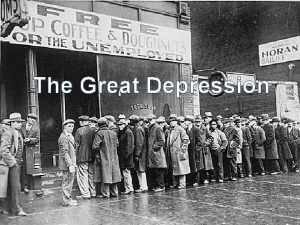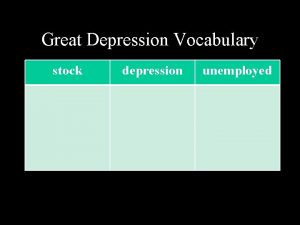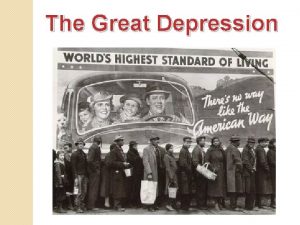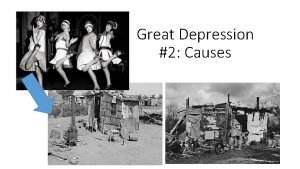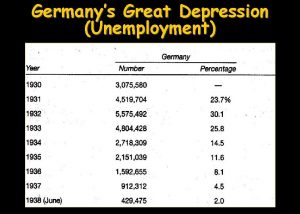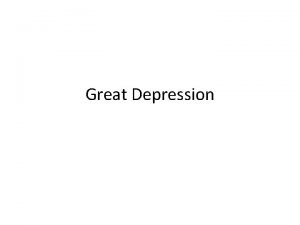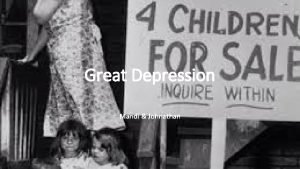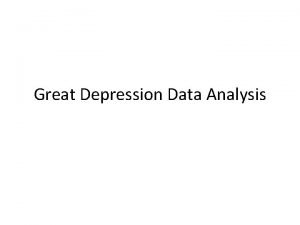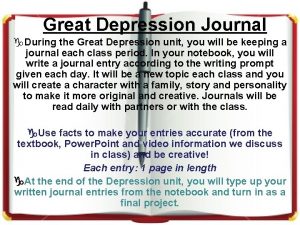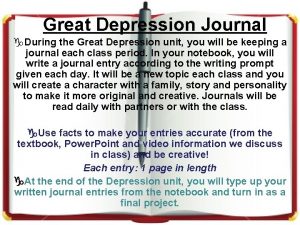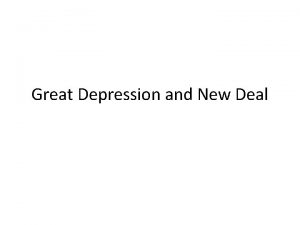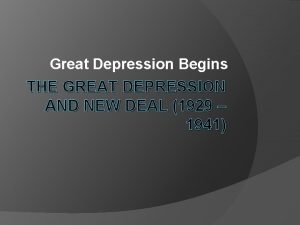Measuring the Great Depression Great Depression What do




































- Slides: 36

Measuring the Great Depression “Great Depression” What do you know? Causes? Recovery? Results?

Why study the “Great Depression”? Read Handout and list 3 reasons in your notes.

Economic Definitions Consumer Price Index (CPI) is a measure of the average change over time in the prices paid by urban consumers for a market basket of consumer goods and services.

Economic Definitions Deflation is a general downward movement of prices for goods and services in an economy.

Economic Definitions Depression is a very severe recession; a period of severely declining economic activity spread across the economy (not limited to particular sectors or regions) normally visible in a decline in real GDP, real income, employment, industrial production, wholesale-retail credit and the loss of the overall confidence in the economy.

Economic Definitions Inflation is a general upward movement of prices for goods and services in an economy .

Economic Definitions Nominal Gross Domestic Product (GDP) is the market value of all final goods and services produced within a country in a year.

Economic Definitions Real Gross Domestic Product (GDP) is the production of all final goods and services within a country valued at constant prices (i. e. , adjusted for inflation or deflation).

Economic Definitions Unemployment rate is the percentage of the labor force who are unemployed.

Inflation -Inflation is a general upward movement of prices for goods and services in an economy. -Prices of individual goods and services rise (and fall) at different rates. Inflation and deflation measure the average or general tendency of price changes. The prices of some things may fall during periods of inflation (e. g. , computers in the 1980 s) even though the prices of the majority of goods and services are rising.

Inflation -You've never experienced high inflation. Most recent was in the 1970 s. -During a period of inflation, if prices increase at a faster rate than people’s salaries or wages, people aren’t able to buy as many goods and services.

Deflation is a general downward movement of prices for goods and services in an economy. Is deflation good for an economy?

Deflation There have also been periods when the U. S. economy experienced deflation. Although falling prices may seem appealing because people could buy more goods and services with their incomes than they could before, there are reasons to be concerned about deflation.

Deflation is often accompanied by falling wages and increasing unemployment. Also, during periods of deflation, debtors have to repay their loans with dollars that are more valuable (i. e. , dollars that have greater purchasing power). So, in essence, debtors have borrowed cheap dollars and are repaying with dollars that will buy more. In addition, consumers and producers who are in debt may suffer; as their incomes drop, their loan payments remain the same.

Effects of Deflation and Inflation Statements 1. Deflation causes the purchasing power of a dollar to increase, because when prices are lower, a dollar will buy more goods and services. 2. Deflation increases the real cost of borrowing, because when the debt is repaid those dollars will purchase more goods and services than when they were originally borrowed.

4. If wages remain the same while prices for goods and services are falling, people are able to purchase more goods and services with the same amount of income. In this case, deflation effectively raises wages. 5. A falling price level implies that firms must sell more goods and services to generate the revenue required to pay their workers. Therefore, firms lay off some employees, causing unemployment to rise and/or firms to decrease workers’ wages. 6. Inflation causes the purchasing power of

8. Because inflation reduces the value of savings, it gives consumers incentives to spend, rather than save. Not everyone’s income rises as much as prices do and, therefore, individuals are not able to buy as many goods and services as they did in the past. 9. Inflation reduces the value of people’s savings because a dollar saved today will not buy as many goods and services tomorrow. 10. Rather than place their savings in bank

Inflation/Deflation Changes in the price of a single good or service or even a few goods and services do not indicate that the economy is experiencing deflation or inflation. Milton Friedman, Nobel Laureate economist, stated, “The high price of cars doesn’t cause inflation any more than a drop in the price of hand calculators causes

Consumer Price Index (CPI) Price stability is important to a healthy economy, price levels for the U. S. economy are measured, and there are several measures. One measure of price level changes with which students may be most familiar is the Consumer Price Index, or CPI. This is a statistic that is reported monthly and indicates annual percentage changes in price levels.

Consumer Price Index (CPI) CPI measures changes in the price levels as experienced by consumers in their day-to-day purchases and is used by economists to analyze the cost of living. It is a way to compare consumers’ purchasing power during different time periods. It also allows people to measure inflation or deflation year-to-year or during

Consumer Price Index (CPI) Look at Visual 1. 3 and answer the questions. • What information is located on the horizontal or X-axis of both graphs? • What information is located on the vertical or Y-axis of both graphs? • What does 0 percent on the vertical axis mean? • When the bar is above 0 percent, is the economy experiencing inflation or deflation?

Gross Domestic Product (GDP) is the market value of all final goods and services produced in an economy in a given year. • Economists use GDP data to measure the growth of the economy by comparing the change in GDP from one year to the next. • The U. S. economy has grown on average about 3. 0 percent to 3. 5 percent annually. • “Market value” refers to the value of goods and services in current prices.

GDP • Only final goods and services are counted. “Final goods and services” are those not used in the production of other goods and services. “Intermediate goods” are those produced and used in the production of another product. • For example, tires produced and used by a car manufacturer to assemble new cars are intermediate goods. Only the car is counted as part of GDP. The tires are not counted.

GDP • Only goods produced during the current year are counted as part of GDP for that year. • Only goods produced within a country’s borders are counted as part of GDP. • When GDP is computed using current prices, inflation makes it

GDP • GDP that has not been adjusted for inflation is referred to as nominal GDP. • If prices have risen and GDP is calculated based on current prices, the change in the size of GDP could be due to the increased prices. To measure growth from year to year, economists adjust nominal GDP for

GDP Pass out 1. 5 Visual What information in shown on the X-axes of both graphs? On the Y-axes of both graphs? What does the trend (dotted) line on the graph indicate? What period in history is most noticeably below trend in GDP? What does this suggest happened during that time?

Civilian Unemployment Rate The unemployment rate represents the number of unemployed as a percentage of the labor force, and an annual unemployment rate is reported monthly by the Department of Labor’s Bureau of Labor Statistics.

Civilian Unemployment Rate -Civilian, noninstitutional persons 16 years of age or older are classified as unemployed if they do not have jobs, have actively looked for work in the prior four weeks and are currently available for work. • Through a monthly survey, the government collects statistics on the unemployed to determine the extent and nature of unemployment. After these statistics are obtained, they have to be interpreted properly so they can be used—together with

Civilian Unemployment Rate -Look at Visual 1. 6 What information is shown on the X and Y axes of both graphs? During what years did the economy experience the lowest rates of unemployment? What events were occurring from 1943 to 1945?

Civilian Unemployment Rate Why would unemployment be lowest at this time? During what year did the economy experience the highest rate of unemployment? What was the rate?

Review What happened to the CPI between 1929 and 1939? Does this mean that the economy on average was experiencing inflation or deflation? What happened to real GDP between 1929 and 1939? What happened to unemployment between 1929 and 1933? When did the unemployment rate return to

Depression is a period of severely declining economic activity spread across the economy (not limited to particular sectors or regions) normally visible in a decline in real GDP, real income, employment, industrial production, wholesale-retail credit and the loss of overall confidence in the economy.

Depression What made this depression “great”?

Depression Falling prices might seem like a good thing, but falling prices lead to reductions in incomes and contribute to rising unemployment. Declining GDP means that not as many goods and services are being produced. Indeed, the Great Depression was the most significant economic catastrophe in U. S. history.

Why, after all this time, do people still study the Great Depression? Can it happen again? What caused it? What role should the government have in the economy?

QUIZ! Vocabulary quiz next class period. Homework! Due next time: “Political Cartoon” and “What's in the Chairman's Briefcase? ”
 Great depression diary entry
Great depression diary entry Brief summary of the great depression
Brief summary of the great depression Hoovers poor farm tobacco fund
Hoovers poor farm tobacco fund Depression/new deal unit vocab
Depression/new deal unit vocab Great depression
Great depression Great depression jeopardy
Great depression jeopardy The great depression summary
The great depression summary Hoovervilles great depression
Hoovervilles great depression Great depression vocab
Great depression vocab Foreclosure great depression
Foreclosure great depression What was the great depression
What was the great depression How did the great depression affect daily life
How did the great depression affect daily life Great depression photographer
Great depression photographer Herbert hoover and franklin roosevelt compare and contrast
Herbert hoover and franklin roosevelt compare and contrast Great depression
Great depression Hoovervilles great depression
Hoovervilles great depression Hardship and suffering lesson 2
Hardship and suffering lesson 2 Describe the human toll of the great depression
Describe the human toll of the great depression Great depression
Great depression Great depression ap world history definition
Great depression ap world history definition Rarig great depression
Rarig great depression Franklin d. roosevelt
Franklin d. roosevelt Cinderella man great depression
Cinderella man great depression What were the long term causes of the great depression
What were the long term causes of the great depression Great depression
Great depression Chapter 22 the great depression begins
Chapter 22 the great depression begins What is deflation
What is deflation Laissez faire great depression
Laissez faire great depression Chapter 14 the great depression begins vocabulary
Chapter 14 the great depression begins vocabulary Five effects of the great depression
Five effects of the great depression Great depression vocabulary jeopardy
Great depression vocabulary jeopardy Great depression timeline
Great depression timeline Hoover's response to the great depression
Hoover's response to the great depression What was hoover's response to the great depression
What was hoover's response to the great depression Great depression political cartoons
Great depression political cartoons Bud not buddy great depression
Bud not buddy great depression Lesson 3 effects of the great depression
Lesson 3 effects of the great depression
